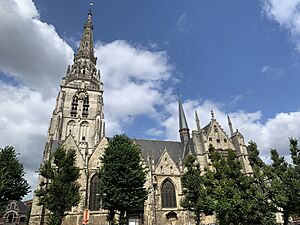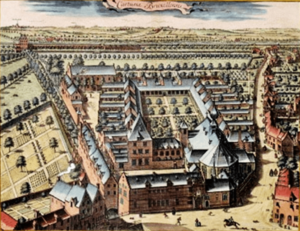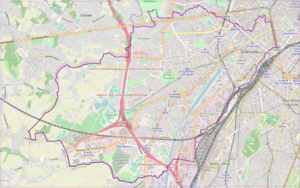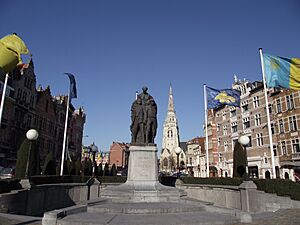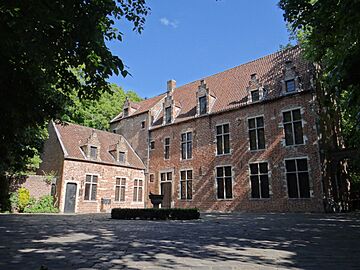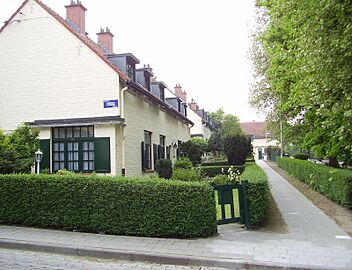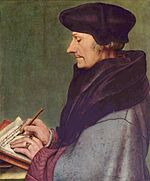Anderlecht facts for kids
Quick facts for kids
Anderlecht
|
|||
|---|---|---|---|
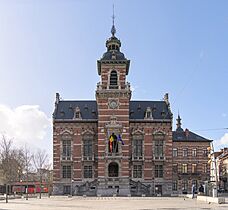
Anderlecht's Municipal Hall seen from the Place du Conseil/Raadsplein
|
|||
|
|||
| Country | Belgium | ||
| Community | Flemish Community French Community |
||
| Region | Brussels | ||
| Arrondissement | Brussels-Capital | ||
| Area | |||
| • Total | 17.74 km2 (6.85 sq mi) | ||
| Population
(2018-01-01)Lua error in Module:Wd at line 1575: attempt to index field 'wikibase' (a nil value).
|
|||
| • Total | Lua error in Module:Wd at line 1,575: attempt to index field 'wikibase' (a nil value). | ||
| Postal codes |
1070
|
||
| Area codes | 02 | ||
| Website | anderlecht.be/fr anderlecht.be/nl |
||
Anderlecht is one of the 19 towns in the Brussels-Capital Region in Belgium. It is located in the southwest part of the region. Anderlecht shares borders with other Brussels towns like City of Brussels, Forest, Molenbeek-Saint-Jean, and Saint-Gilles. It also borders the Flemish towns of Dilbeek and Sint-Pieters-Leeuw. Like all towns in Brussels, it is officially bilingual, meaning both French and Dutch are spoken.
Anderlecht has many different neighborhoods, each with its own history and style of buildings. As of 2022, about 122,547 people live there. The total area of Anderlecht is about 17.91 square kilometers. This means it has about 6,842 people living in each square kilometer. The higher parts of the town are greener and have fewer people.
Contents
History of Anderlecht
Early Times and Middle Ages
People have lived in the Anderlecht area for a very long time. Signs of human life from the Stone Age and Bronze Age have been found. There were also remains of a Roman house and a Frankish burial ground. The name Anderlecht was first written down in 1047. Back then, it was already an important community with religious leaders and two large estates.
In 1356, a battle called the Battle of Scheut happened in Anderlecht. The Count of Flanders fought against Brussels. Even though he won for a short time, the Duchess of Brabant got her title back the next year. In 1393, Anderlecht officially became part of Brussels. Around this time, the church of Saint Guy was rebuilt in a beautiful Gothic style. It was built over an older Romanesque underground room.
From the 1400s to the 1700s
Anderlecht became a center for culture in the 15th and 16th centuries. In 1521, a famous Dutch writer and thinker named Erasmus of Rotterdam lived in a house for religious leaders for a few months.
The 17th and 18th centuries saw many wars between the Low Countries and France. In 1695, Brussels was heavily bombed from a high area in Anderlecht called Scheut. This bombing and the fires that followed caused the most damage in Brussels' history. In 1792, a French army defeated the Austrians in Anderlecht. After this, Anderlecht became an independent town.
By the end of the 1700s, Anderlecht had about 2,000 people. There was a popular chapel called Our Lady of Scheut, known for its nice location.
The 1800s and Beyond
The 19th century brought a huge increase in people moving to Anderlecht. This was mainly because Brussels was growing fast nearby. New roads were built, and the population grew ten times between 1830 and 1890. It doubled again by 1910. Many factories and working-class neighborhoods were built along the roads and the Brussels–Charleroi Canal.
In the early 1900s, new housing areas and "garden cities" like La Roue/Het Rad were built for all the new residents. After World War II, some green areas were also used for large housing projects. Today, Anderlecht is well-known in Belgium because of its very successful football club.
Geography
Location of Anderlecht
Anderlecht is in the middle-north part of Belgium. It's about 110 kilometers from the Belgian coast. It is the westernmost town in the Brussels-Capital Region. The Brussels–Charleroi Canal cuts through the town, dividing it into two parts. Anderlecht is the third largest town in the Brussels region, after the City of Brussels and Uccle. It borders the City of Brussels, Forest, Molenbeek-Saint-Jean, and Saint-Gilles. It also borders the Flemish towns of Dilbeek and Sint-Pieters-Leeuw.
Weather in Anderlecht
Anderlecht, like the rest of Brussels, has an oceanic climate. This means it has warm summers and cool winters. The nearby coast brings air from the Atlantic Ocean, which affects the weather. On average, it rains about 135 days a year. Snow doesn't fall very often, only about 24 days a year. Thunderstorms can be strong in the summer.
The main weather station for Belgium is in Uccle, which is close to Anderlecht. So, the weather records there are very similar to what you would find in Anderlecht.
| Climate data for Brussels-Capital Region (1981–2010) | |||||||||||||
|---|---|---|---|---|---|---|---|---|---|---|---|---|---|
| Month | Jan | Feb | Mar | Apr | May | Jun | Jul | Aug | Sep | Oct | Nov | Dec | Year |
| Mean daily maximum °C (°F) | 5.9 (42.6) |
6.8 (44.2) |
10.5 (50.9) |
14.2 (57.6) |
18.3 (64.9) |
20.9 (69.6) |
23.3 (73.9) |
23.0 (73.4) |
19.5 (67.1) |
15.1 (59.2) |
9.8 (49.6) |
6.3 (43.3) |
14.5 (58.1) |
| Daily mean °C (°F) | 3.2 (37.8) |
3.5 (38.3) |
6.5 (43.7) |
9.5 (49.1) |
13.5 (56.3) |
16.1 (61.0) |
18.4 (65.1) |
18.0 (64.4) |
14.9 (58.8) |
11.1 (52.0) |
6.8 (44.2) |
3.8 (38.8) |
10.4 (50.7) |
| Mean daily minimum °C (°F) | 0.7 (33.3) |
0.6 (33.1) |
2.9 (37.2) |
4.9 (40.8) |
8.7 (47.7) |
11.5 (52.7) |
13.6 (56.5) |
13.0 (55.4) |
10.5 (50.9) |
7.5 (45.5) |
4.5 (40.1) |
1.5 (34.7) |
6.7 (44.1) |
| Average precipitation mm (inches) | 75.2 (2.96) |
61.6 (2.43) |
69.5 (2.74) |
51.0 (2.01) |
65.1 (2.56) |
72.1 (2.84) |
73.6 (2.90) |
76.8 (3.02) |
69.6 (2.74) |
75.0 (2.95) |
77.0 (3.03) |
81.4 (3.20) |
848.0 (33.39) |
| Average precipitation days (≥ 1 mm) | 12.8 | 11.1 | 12.7 | 9.9 | 11.3 | 10.5 | 10.1 | 10.1 | 10.4 | 11.2 | 12.6 | 13.0 | 135.6 |
| Mean monthly sunshine hours | 58 | 75 | 119 | 168 | 199 | 193 | 205 | 194 | 143 | 117 | 65 | 47 | 1,583 |
| Source: KMI/IRM | |||||||||||||
Neighborhoods of Anderlecht
Anderlecht has many different neighborhoods. Some are large, while others are smaller residential or former industrial areas. The area along the canal is currently being rebuilt and improved.
Historical Center
This is the main central part of Anderlecht. It used to be called Rinck. It has a few important areas:
- The Saint-Guidon/Sint Guido area is the heart of Anderlecht. Here you'll find the Place de la Vaillance/Dapperheidsplein (the main square), the Church of St. Guido, and the main schools. The Rue Wayez/Wayezstraat is the main shopping street.
- The smaller Aumale area includes the Erasmus House, which is a museum about the famous writer Erasmus. It also has an old beguinage, which was a place where religious women lived together. This is now a museum too.
Cureghem/Kuregem
Cureghem/Kuregem is one of the biggest and most populated neighborhoods in eastern Anderlecht. It grew a lot during the Industrial Revolution because of its location along the Brussels–Charleroi Canal. The Town Hall is located here.
La Roue/Het Rad
Located in the south of Anderlecht, La Roue/Het Rad means "The Wheel." It's one of the largest neighborhoods and a famous "garden city" in Brussels. It was built in the 1920s with charming, simple houses. It also has a large campus for food and chemical industries, called CERIA/COOVI.
Scheut
Scheut is in the north of Anderlecht. It borders Molenbeek-Saint-Jean and has a natural area called Scheutbos. This area is known for the Scheutveld College, founded in 1863 by a Catholic priest. From here, missionaries went to places like China and Congo.
Main Places to See
Anderlecht has many interesting cultural and historical sites:
- The Collegiate Church of St. Peter and St. Guido: This church is in the historical center. It holds the grave of Saint Guy. Its oldest part, an underground room, is from the 10th century.
- The Erasmus House: Built between 1460 and 1515, this house has beautiful gardens. You can visit it to learn about Erasmus. Next to the church, the old beguinage is now a museum about religious community life.
- The National Museum of the Resistance: This museum tells the story of the Belgian people who fought against the German occupation during World War II.
- The Museum of China – Scheut: This museum has items brought back by missionaries from China, including a 15th-century bronze Buddha statue.
- The Maurice Carême Museum: This is the house where the Belgian poet Maurice Carême lived and wrote.
- The Luizenmolen: This is a copy of an old windmill that used to be in Neerpede.
- The Cureghem Cellars: These are underground brick tunnels with cool arches. They used to be part of a cattle market. Now, they are used for different events.
- The Cantillon Brewery: This is a museum about gueuze beer, located in a real working brewery.
- The Museum of Medicine: You can find this museum on the Erasme/Erasmus campus of the Université libre de Bruxelles (ULB).
- The Jean-Claude Van Damme statue: A statue of the famous actor is located near the Westland Shopping Center.
Population of Anderlecht
How the Population Changed
In the early 1800s, Anderlecht had only about 2,000 people. But after the Industrial Revolution, many more people moved there. The population grew a lot, reaching its highest point of 103,796 in 1970. Then it went down a bit, to 87,812 in 2000, before growing quickly again in recent years.
As of January 1, 2020, Anderlecht had 120,887 people. The area is 17.91 square kilometers, meaning there are about 6,749 people per square kilometer.

- Sources: INS: 1806 to 1981= census; 1990 and later = population on 1 January
People from Other Countries
Many people from different countries live in Anderlecht. Here are some groups with over 1,000 people as of January 1, 2020:
| 7,405 | |
| 4,924 | |
| 2,985 | |
| 2,743 | |
| 2,727 | |
| 2,628 | |
| 2,549 | |
| 1,717 |
| Group of origin | Year | |
|---|---|---|
| 2023 | ||
| Number | % | |
| Belgians with Belgian background | 22,685 | 18.14% |
| Belgians with foreign background | 59,274 | 47.39% |
| Neighbouring country | 2,231 | |
| EU27 (excluding neighbouring country) | 5,661 | |
| Outside EU 27 | 51,382 | 41.08% |
| Non-Belgians | 43,106 | 34.47% |
| Neighbouring country | 3,371 | |
| EU27 (excluding neighbouring country) | 18,387 | |
| Outside EU 27 | 21,348 | 17.07% |
| Total | 125,065 | 100% |
Events
The yearly Anderlecht fair started in 1825. It was first a cattle fair. Today, it's a big celebration with animal shows, a large market, a flower show, and a religious parade honoring Saint Guy.
Economy
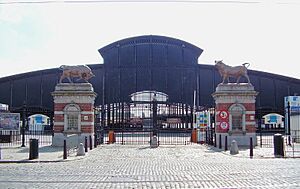
The Abattoirs of Anderlecht is the main slaughterhouse in Brussels. It employs about 1,500 people. The large hall also serves as a covered market for food and flea markets.
Many big international companies have their main offices in Anderlecht. These include the Delhaize Group, which runs many supermarkets, Coca-Cola Benelux, and the Belgian chocolate company Leonidas.
Healthcare
Anderlecht has several hospitals and clinics:
- Erasmus Hospital
- Jules Bordet Institute
- Joseph Bracops Hospital
- St. Anne St. Remigius Clinic
Sports
Football
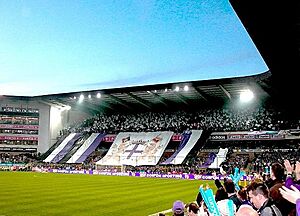
Anderlecht is home to the football club RSC Anderlecht. This is the most successful Belgian football team in European competitions. They have won the Belgian First Division 34 times. The team plays its home games at the Constant Vanden Stock Stadium. Their team colors are white and purple.
Parks and Green Spaces
Anderlecht has many green areas for people to enjoy:
- Astrid Park
- Parc Forestier/Bospark, in Scheut
- Scherdemael Park
- Peterbos Park
- Joseph Lemaire Park
- Jean Vives Park
- Parc des Étangs/Vijverspark, in Neerpede
- Parc de la Rosée/Dauwpark, in Cureghem
- The Vogelzang or Vogelenzang, a protected natural area
Famous People from Anderlecht
- Saint Guy (around 950–1012), known as the Poor Man of Anderlecht, a patron saint of the town.
- Adrian VI (1459–1523), a pope and theologian who lived here.
- Jacques Brel (1929–1978), a famous singer-songwriter and actor. He lived and worked in Anderlecht for many years. A nearby metro station is named after him.
- Maurice Carême (1899–1978), a poet.
- Desiderius Erasmus (1466–1536), a famous thinker and theologian.
- Philippe Thys (1889–1971), a cyclist who won the Tour de France three times.
- Toots Thielemans (1922–2016), a famous jazz musician who lived in Anderlecht.
- Constant Vanden Stock (1914–2008), a football player, coach, and businessman.
- Princess Elisabeth (born 2001), the oldest child of King Philippe and Queen Mathilde of Belgium. She is next in line to the throne.
- Princes Gabriel and Emmanuel and Princess Eléonore; also in line to the Belgian throne.
Anderlecht's International Friends
Twin Towns and Sister Cities
Anderlecht has special partnerships with other towns around the world:
 Boulogne-Billancourt, France
Boulogne-Billancourt, France Berlin-Neukölln, Germany
Berlin-Neukölln, Germany London Borough of Hammersmith and Fulham, United Kingdom
London Borough of Hammersmith and Fulham, United Kingdom Zaandam, Netherlands
Zaandam, Netherlands Marino, Italy
Marino, Italy
Anderlecht also has a friendship agreement with:
See also
 In Spanish: Anderlecht para niños
In Spanish: Anderlecht para niños





